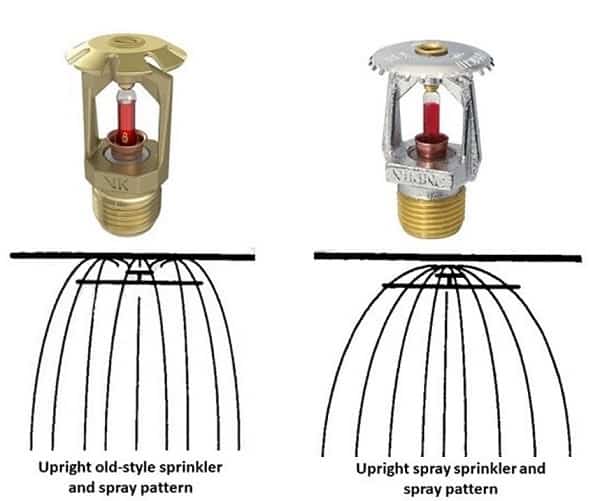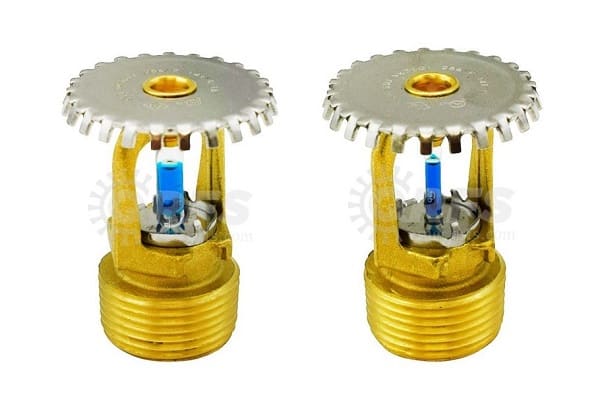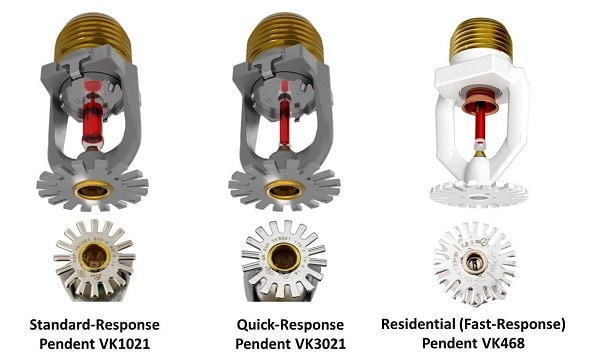Quick and standard response sprinklers differ in how fast they activate—but what else is different? And what about residential sprinklers?
Designed to activate earlier than “standard-response” fire sprinklers, quick-response (QR) sprinklers are among the most useful tools in fire protection. Because they go off earlier in a blaze, QR heads deliver water to control a fire sooner, prioritizing the safe escape of occupants.
But if you’re new to fire protection (and even for some veterans), it can be easy to get confused about QR sprinklers. You might wonder what exactly makes them “quick-response.” After all, sprinklers come with fixed activation temperatures. So how can one sprinkler activate before another without having a lower activation temperature? And why?
Plus, other sprinklers are designed to activate early. Residential sprinklers and certain kinds of storage sprinklers are fast-acting, too. Are all these “quick-response” sprinklers?
There’s a lot of misinformation about quick-response sprinklers on the internet. So, QRFS will attempt to clarify things.
Here are the essentials to know about response speed and fire sprinklers:
- Quick response, residential, and early suppression fast response (ESFR) fire sprinklers all use “fast-response” elements, making them all “fast-response sprinklers.”
- A fast-response element is a fusible link or bulb that responds more quickly to temperature changes.
- Quick response sprinklers are nearly identical to standard response (SR) sprinklers—the only difference is the fast-response element.
- Residential sprinklers, while also fast response, are fundamentally different from QR and SR sprinklers—and most of the difference from QR is in the deflector.
Read on to learn about the history of QR sprinklers and some of the technical differences between standard, QR, residential, and ESFR sprinklers.
QRFS has fire sprinklers for any application, including commercial sprinklers (quick response or standard response) and residential models.
The invention of fast-response elements
The history of fire sprinklers stretches back to the Renaissance—Leonardo Da Vinci had a prototype fire sprinkler system, though it was mostly a disaster. Fire sprinklers, as we understand them today, arrived when the Connecticut inventor and piano maker Henry S. Parmalee installed the first automatic fire sprinkler system in 1874.
Until 1953, fire sprinklers had what we now call “conventional” or “old-style” deflectors, which would throw between 40 and 60% of their discharged water initially upwards rather than downwards. Old-style sprinklers also had very vertical spray patterns. Now, we have spray sprinklers that create an umbrella pattern and release water from upright, pendent, and horizontal (sidewall) orientations.
In the late 1940s and early 1950s, engineers at Factory Mutual Laboratories (now FM Global) invented what we now know as the spray sprinkler. Spray sprinklers have characteristic 100%-downward umbrella-shaped spray patterns that cover a larger floor area than old-style sprinklers. Spray sprinklers quickly became the default, being called “standard sprinklers” in the 1958 edition of NFPA 13: Standard for the Installation of Sprinkler Systems. Excluding some storage sprinklers and other special applications, nearly all commercial fire sprinklers are spray sprinklers.

Residential sprinklers and the fast response element
It’s taken a while, but sprinklers for residential settings are becoming more common. It took time for standards and sprinkler designs to adapt to the needs of homes and apartments. For instance, residential sprinklers have different water deflectors and spray patterns that emphasize providing a survivable space for occupants rather than comprehensively protecting property.
It was the innovation in residential sprinklers that led to the invention of the fast-response element. In the 1960s, a “quick-response subcommittee” was formed within the NFPA 13 committee. It had become apparent to many that residential sprinklers needed to activate sooner than their commercial counterparts to be useful in dwellings. Faster-acting sprinklers would promote earlier fire control and life safety while requiring less water, with the water supply being a limiting factor in many residential settings.
In 1981, the first listed residential sprinkler head was produced. Residential fast-response sprinklers have an element featuring a smaller, thinner bulb that make them more sensitive to temperature changes without fundamentally changing the temperature at which they activate.

Adding the fast-response element to commercial sprinklers
As Professor Kenneth Isman explained in Issue 252 of the National Fire Sprinkler Association’s e-Tech Notes, sprinkler manufacturers quickly saw the utility of these fast response elements for commercial applications. If sprinkler heads were activated sooner, fewer sprinkler heads would need to go off, period. These elements could control fires quicker, reduce water damage, and even reduce the pressure necessary in a system.
To meet the needs of the commercial market, manufacturers began combining fast-response elements with spray sprinkler deflectors. Soon, listing standards and installation standards caught up, and the quick-response spray sprinkler was first officially described in the 1996 edition of NFPA 13.
Fast-response elements also found use in special applications, namely, storage. Early-suppression fast-response (ESFR) sprinklers combine these elements with a high-pressure downward spray to quickly extinguish (not just control) fires in challenging warehouse settings.
For more information, check out our articles on the history of fire sprinklers and the many different kinds of sprinklers.
Technical details & the physical differences between quick response, standard response, and residential sprinklers
This is all a pretty cool story, but QRFS loves details. And many online sources mistakenly describe residential [fast-response] sprinklers as “quick response sprinklers.” In truth, while both types are fast response sprinklers, there are critical differences between them—along with distinctions between these models and standard response sprinklers.
Let’s dive into the nitty-gritty of different sprinkler types, including:
- How sprinkler response speed is measured
- How sprinkler spray patterns work
- Design considerations for SR, QR, and residential
- Listing requirements for different sprinkler types
Measuring sprinkler response with RTI
As we discussed, fast-response bulbs and links were initially developed for residential sprinklers and systems but soon applied to commercial settings, leading to the development of the now-ubiquitous QR sprinkler. But who decides what “fast-response” is?
A sprinkler’s response speed is measured, as Viking explains, with a plunge test performed as part of its listing requirements. In this test, a sprinkler is suddenly inserted into a “plunge oven”—really, a glorified convection oven—that circulates air at a constant high temperature. The time between insertion and activation (in other words, when the bulb bursts or the link solders) determines the response time index (RTI).
Check out this video from Dyne Fire Protection Labs demonstrating the plunge test:
RTI essentially measures how long it takes for the sprinkler’s bulb or link to go from room temperature to activation temperature. The shorter this time, the lower the RTI.
NFPA 13 defines “fast-response” and “standard-response” sprinklers based on these RTI values (3.3.205.4):
- Fast response sprinklers have RTIs of 50 or less.
- Standard response sprinklers have RTIs of 80 or more.
Remember, “fast-response” is an umbrella term with three different types of sprinklers beneath it: QR, residential, and early-suppression fast-response (ESRF). All of these sprinklers have a similar link or bulb with an RT1 less than or equal to 50.
From there, the difference between varying types of fast response sprinklers mainly lies in the deflector plates, which determine the spray pattern and functionality. None of these sprinklers are interchangeable. QR sprinklers are not the same as residential sprinklers!
Sprinkler deflectors and spray patterns
Spray pattern is a crucial characteristic of fire sprinklers. The way they spray water determines how effective they are at different jobs. There are two main variables in fire sprinkler spray patterns: droplet size and spray angle.
Droplets, as Kenneth Isman explains, come in three sizes and perform three separate functions:
- Small droplets provide cooling, absorbing the heat of a fire.
- Medium droplets are useful for pre-wetting combustible materials near a fire.
- Large droplets penetrate a fire plume where smaller droplets would vaporize. These directly attack a fire.
The angle of spray refers to how widely sprinklers throw water. Some sprinklers have very narrow, downward spray patterns, whereas others discharge widely and cover a larger floor area. As we mentioned, old-style sprinklers had highly vertical spray patterns, while modern spray sprinklers make an umbrella shape.

To differentiate between QR, SR, and residential sprinklers, remember these two essential facts. First, the QR and standard response versions of a similar model of sprinkler have the same deflector. When it comes to spray patterns, they are identical. They deliver whatever mixture of small, medium, and large droplets in an umbrella pattern designed to provide comprehensive wetting.
Second, remember that residential sprinklers are not standard or quick response sprinklers. They use unique deflectors that create a different spray pattern focused on small and medium droplets. Residential sprinklers have a broader, higher spray pattern along with that different droplet size. This design prioritizes wall-wetting and was developed to enhance survivability for residents who may have a limited water supply.
Standards and listings for fast response sprinklers
Testing is everything in fire protection. Design and installation standards from the National Fire Protection Association (NFPA) are largely based on meticulous testing. Moreover, most functional components in a fire sprinkler system must be “listed”—that is, tested and approved by a nationally recognized testing laboratory (NRTL) such as UL or FM Global.
Here’s how QR and residential sprinklers fit into NFPA standards and various performance listings.
NFPA 13 incentivizes using QR sprinklers in some situations
Because QR sprinklers open faster and thus may control fires sooner, NFPA 13 encourages designers to use them instead of standard response sprinklers in certain conditions. Specifically, designers can employ QR sprinklers where (19.3.3.2.3.1):
- The occupancy is light or ordinary hazard (the only time QR is allowed)
- The sprinkler system is wet-pipe
- The ceiling is no more than 20 feet high
- There are no unprotected ceiling pockets covering more than 32 ft.2
- There are no unprotected areas above cloud ceilings
An incentive for using QR sprinklers is their hydraulic advantage, which is ultimately also a cost-efficiency. Sprinkler system design revolves around water density—the amount of water that can be sprayed over a given area in a given time. And this “given area” is essentially based on a worst-case scenario design area. NFPA 13 issues numerous rules for selecting and sizing the design area and determining the design density. You can read more about the whole process in our previous blog.
The QR incentive is this: when the above criteria are met, QR sprinklers allow a designer to shrink the design area without reducing the density. Here are some hypothetical values showing how this translates to a hydraulic advantage:
| Without Quick-Response | With Quick Response |
|---|---|
| Design density: 0.15 gpm/ft.2 | Design Density: 0.15 gpm/ft2 |
| Design area: 1500 ft.2 | Design area: 900 ft.2 |
| Required flow in design area: 225 gpm | Required flow in design area: 135 gpm |
| *Based on ordinary-hazard density/area curves and taking a 40% design area reduction for 10 ft. ceilings. | |
A hydraulic advantage translates to a financial benefit. To understand this, consider this summation of a piece by Steven Scandaliato of the American Fire Sprinkler Association (AFSA): flow means pressure, and pressure costs money. Engineering the water supply can easily be the most expensive part of a fire sprinkler system. For example, if QR sprinklers let designers avoid specifying a fire pump, they can save many tens of thousands of dollars without compromising life safety.
Residential sprinklers and NFPA 13D
Residential sprinklers perform a somewhat different function than commercial fire sprinklers, so the design of most residential systems uses separate rules found in NFPA 13D: Standard for the Installation of Sprinkler Systems in One- and Two-Family Dwellings and Manufactured Homes.
Applicable in homes, duplexes, and similar structures, NFPA 13D systems do not cover quite as much area as NFPA 13 systems. Their protected areas focus on where the loss of life during a fire is more likely without sprinklers—such as bedrooms, living rooms, and kitchens. They promote life safety and escape, not comprehensive property protection—though residential systems often succeed at doing both. Where NFPA 13 may require coverage, NFPA 13D allows places like garages, closets, attics, bathrooms, equipment rooms, and concealed spaces to remain unprotected by fire sprinklers.
Additionally, NFPA 13D issues relaxed requirements for hydraulic design compared to NFPA 13. NFPA 13D (10.1.1) only requires a minimum density of 0.05 GPM/ft2 or the sprinkler’s listing, whichever is greater. Comparatively, the minimum residential density in NFPA 13 is 0.1 GPM/ft2 (19.4.1.3).
Listing standards for residential and quick response sprinklers
If any confusion remains about whether QR and standard response sprinklers are the same except for the response time, look no further than the UL testing and listing standards for different models.
UL’s standards for commercial and residential fire sprinklers are found in UL 199: Standard for Automatic Sprinklers for Fire-Protection Service. UL 199 provides the rules for testing all of these models. And while residential sprinklers have several different characteristics, QR and SR sprinklers have fundamentally the same deflectors and spray patterns, really just differing in how fast they go off.
Residential, standard response, and quick response sprinklers have different features for different roles
More sensitive to heat, fast response elements activate sooner than standard fire sprinkler links and bulbs. This fast-acting functionality was first developed for residential fire sprinklers, but multiple types of sprinklers now use the technology.
Ultimately, “fast response” is a category of sprinklers with the same type of element and includes QR commercial sprinklers, residential sprinklers, and early-suppression fast-response sprinklers. Each of these platforms performs a different function and has a different deflector to develop a different spray pattern. Even though they all go off quicker, they are all designed for different situations.
Whether you need quick-response sprinklers for commercial settings or residential sprinklers for one- and two-family dwellings, QRFS can get you what you need.
Call us at +1 (888) 361-6662 or email support@qrfs.com with questions about our selection of fire protection tools and equipment.
This blog was originally posted at blog.qrfs.com. If this article helped you, check us out at Facebook.com/QuickResponseFireSupply or on Twitter @QuickResponseFS.


we are the training agency , requested please from your side to send us a presentation of sprinklers all types
Your blogs are so helpful. Thanks for the service!
I do have one question on #390. It sounds like you are saying that Residential Pendents are ‘fast release’ by nature, but not quick release per se.
“…many online sources mistakenly describe residential [fast-response] sprinklers as “quick response sprinklers.””
“…remember that residential sprinklers are not standard or quick response sprinklers.”
A sprinkler head in my cabinet is clearly labeled VK468 QR RES PEND 155… Doesn’t this mean it is a Quick Release Residential Pendent? I want to make sure I list it correctly on my cabinet label, but I’m confused.
JR — The terms are sometimes used interchangeably in industry publications, etc., but residential sprinklers are explicitly called fast response, in our experience. For example, the data sheet for a VK468 explicitly states: “Viking residential automatic sprinklers are equipped with a ‘fast response’ heat-sensitive operating element designed to respond individually and quickly to a specific high temperature.”
Where are you saying you see this label; on the sprinkler’s deflector? When we get a moment, we’ll pull out some VK468s and check the labeling. Regardless, these sprinklers are fast response.
Yes, on the deflector. I can send a photo if it’s helpful.
I’ve also noticed that some of the orange sprinkler head casings are labeled with stickers indicating SR and LR. I assume SR is for standard release but what would LR mean?